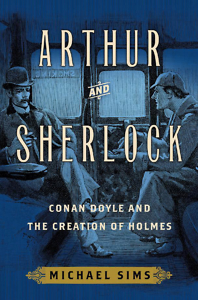In A Study in Scarlet, the first of the Sherlock Holmes stories, the great detective states, “There is nothing new under the sun. It has all been done before.” The words, placed in Holmes’s mouth by his creator, Arthur Conan Doyle, refer to a historical murder case that shared elements with the one Holmes was investigating. As Michael Sims has delightfully demonstrated in his new biography, Arthur and Sherlock: Conan Doyle and the Creation of Holmes, the famous quotation—appropriated from the Biblical book of Ecclesiastes—could also refer to the origins of Holmes himself, a creation born from Doyle’s appreciation of early detective stories and his friendship with a remarkably perceptive medical doctor.

Arthur Conan Doyle was born in Scotland to a proud but poor family of artists. His poverty put him in contact with the rough side of life, from street fighting to caring for an alcoholic father. The family connections, however, also gave him a love of the arts. “Born to an artistic legacy,” writes Sims, “he had been drawn to literature from his earliest memory, and from a young age he encountered writers.” Among the works admired in the Doyle household were those of the American essayist Oliver Wendell Holmes, whose surname became a favorite of Arthur’s. The love of reading and learning served young Doyle well, and he became an outstanding medical student at the University of Edinburgh, where he met the man who would change not only Doyle’s life but the lives of millions of future fans of detective fiction.
There has never been any mystery regarding the effect Dr. Joseph Bell had on the creation of Sherlock Holmes. Bell both amazed and influenced many students with his ability to diagnose patients on sight, identifying not only their physical ailments but also their professions, places of birth, hobbies, and marital status. Doyle always credited his medical-school teacher with inspiring the preternaturally observant Holmes, and Bell was interviewed several times about it.
But Sims doesn’t merely identify Bell as one of Doyle’s principal inspirations. He explores the people and ideas that influenced Bell, investigating the origins of the science of observation and even the scientific method itself—ideas that would not only change the practice of medicine but also spur the evolution of criminal justice. Doyle lived at a time when science was coming to dominate nearly all aspects of life, and the idea of a scientific detective—a person driven not by revenge or a need to prove his innocence but by the search for truth—was gaining acceptance.
Sims, a Crossville native who lived for many years in Nashville, has built a solid reputation as an editor of classic story collections and an author of many works of nonfiction. With his last two books—The Story of Charlotte’s Web and The Adventures of Henry Thoreau—he pioneered what amounts to a new genre: the biography of a particular book. Sims’s expertise in both literature and history is again on display in Arthur and Sherlock, which includes analyses of detectives both fictional and real, and the times that produced them.
By the mid-nineteenth century, the profession of catching criminals—a practice previously known as “thieftaking”—had been reinvented. Sims refers to it “as a combination of observation, evidence, and courage—an idealized image of science in the pursuit of justice.” And in the literary realm of Doyle’s youth there was no greater exemplar of this ideal than C. Auguste Dupin, the unforgettable creation of Edgar Allan Poe.
 Dupin was not the first fictional detective, but Poe made him arguably the most famous of his age in adventures such as “The Murders in the Rue Morgue” and “The Purloined Letter.” A relative of Doyle’s had recommended Poe’s stories to the young man, surely not realizing how the suggestion would change the literary world. Poe’s detective, practicing what his author described as “ratiocination,” solved mysteries by seeing what others could not. He deduced from observation. He was coldly scientific. Sims, noting the obvious similarities to Holmes, writes, “In creating his own detective, Arthur naturally recast Dupin’s influence in his own, later, less romantic era.” Upon the appearance of A Study in Scarlet in 1887, the public fell in love with Sherlock Holmes and his colleague, Dr. John Watson.
Dupin was not the first fictional detective, but Poe made him arguably the most famous of his age in adventures such as “The Murders in the Rue Morgue” and “The Purloined Letter.” A relative of Doyle’s had recommended Poe’s stories to the young man, surely not realizing how the suggestion would change the literary world. Poe’s detective, practicing what his author described as “ratiocination,” solved mysteries by seeing what others could not. He deduced from observation. He was coldly scientific. Sims, noting the obvious similarities to Holmes, writes, “In creating his own detective, Arthur naturally recast Dupin’s influence in his own, later, less romantic era.” Upon the appearance of A Study in Scarlet in 1887, the public fell in love with Sherlock Holmes and his colleague, Dr. John Watson.
“Arthur,” writes Sims, “had merged the characters he met in real life and in fiction, embodied his own reckless bravery and burgeoning passion for justice, and married a Romantic vision of science to the myth of the heroic adventurer.” In Arthur and Sherlock Sims has written not just a wonderful narrative of the invention of a beloved character but a case study of the creative process. By following all the leads and tracking down all the clues that led Doyle to Holmes, Sims illustrates the miracle of literature.
[To read an excerpt of Arthur and Sherlock, click here.]

A Michigan native, Chris Scott is an unrepentant Yankee who arrived in Nashville more than twenty-five years ago and has gradually adapted to Southern ways. He is a geologist by profession and an historian by avocation.
Tagged: 2017 Southern Festival of Books, Michael Sims, Nonfiction





